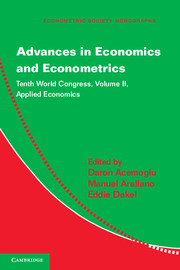Book contents
- Frontmatter
- Contents
- Contributors
- Preface
- I FINANCE
- II POLITICAL ECONOMY
- III MACROECONOMICS
- 5 Job Search, Labor-Force Participation, and Wage Rigidities
- 6 From Wages to Welfare: Decomposing Gains and Losses from Rising Inequality
- IV TRADE AND FIRM DYNAMICS
- V GROWTH
- VI FRISCH LECTURE
- VII PERSPECTIVES ON CHINESE ECONOMIC GROWTH
- Name Index
- Miscellaneous Endmatter
5 - Job Search, Labor-Force Participation, and Wage Rigidities
Published online by Cambridge University Press: 05 May 2013
- Frontmatter
- Contents
- Contributors
- Preface
- I FINANCE
- II POLITICAL ECONOMY
- III MACROECONOMICS
- 5 Job Search, Labor-Force Participation, and Wage Rigidities
- 6 From Wages to Welfare: Decomposing Gains and Losses from Rising Inequality
- IV TRADE AND FIRM DYNAMICS
- V GROWTH
- VI FRISCH LECTURE
- VII PERSPECTIVES ON CHINESE ECONOMIC GROWTH
- Name Index
- Miscellaneous Endmatter
Summary
Introduction
A flurry of recent research explores why unemployment is so volatile at business-cycle frequencies, typically assuming that labor-force participation is constant, so volatility of unemployment is simply the converse of volatility of employment. However, in reality, workers sometimes exercise the option to drop out of the labor force. For example, during the recent recession in the United States, the labor-force participation rate fell from about 66 to 64 percent. In fact, as I write, it fell quarter-on-quarter for 10 of the 11 quarters since the recession officially began at the beginning of 2008. This chapter first documents changes in the labor-force participation rate and the flow of workers among employment, unemployment, and inactivity (i.e., nonparticipation). It then explores whether a job-search model is consistent with those changes. My conclusion is affirmative if wages are rigid and the level of wages is above the social optimum on average.
As a matter of theory, it is unclear whether labor-force participation should be procyclical or countercyclical in a job-search model. On the one hand, a decline in employment may draw new job searchers into the labor market. On the other hand, the difficulty of finding employment may discourage nonemployed workers from looking for a job. I develop an extension to a standard model of job search (Pissarides 2000) that can capture these trade-offs. At the start of every time period, some individuals are employed and some are not. Nonemployed workers must decide whether to look for a job (i.e., be unemployed) or to remain inactive.
- Type
- Chapter
- Information
- Advances in Economics and EconometricsTenth World Congress, pp. 197 - 234Publisher: Cambridge University PressPrint publication year: 2013
- 19
- Cited by



